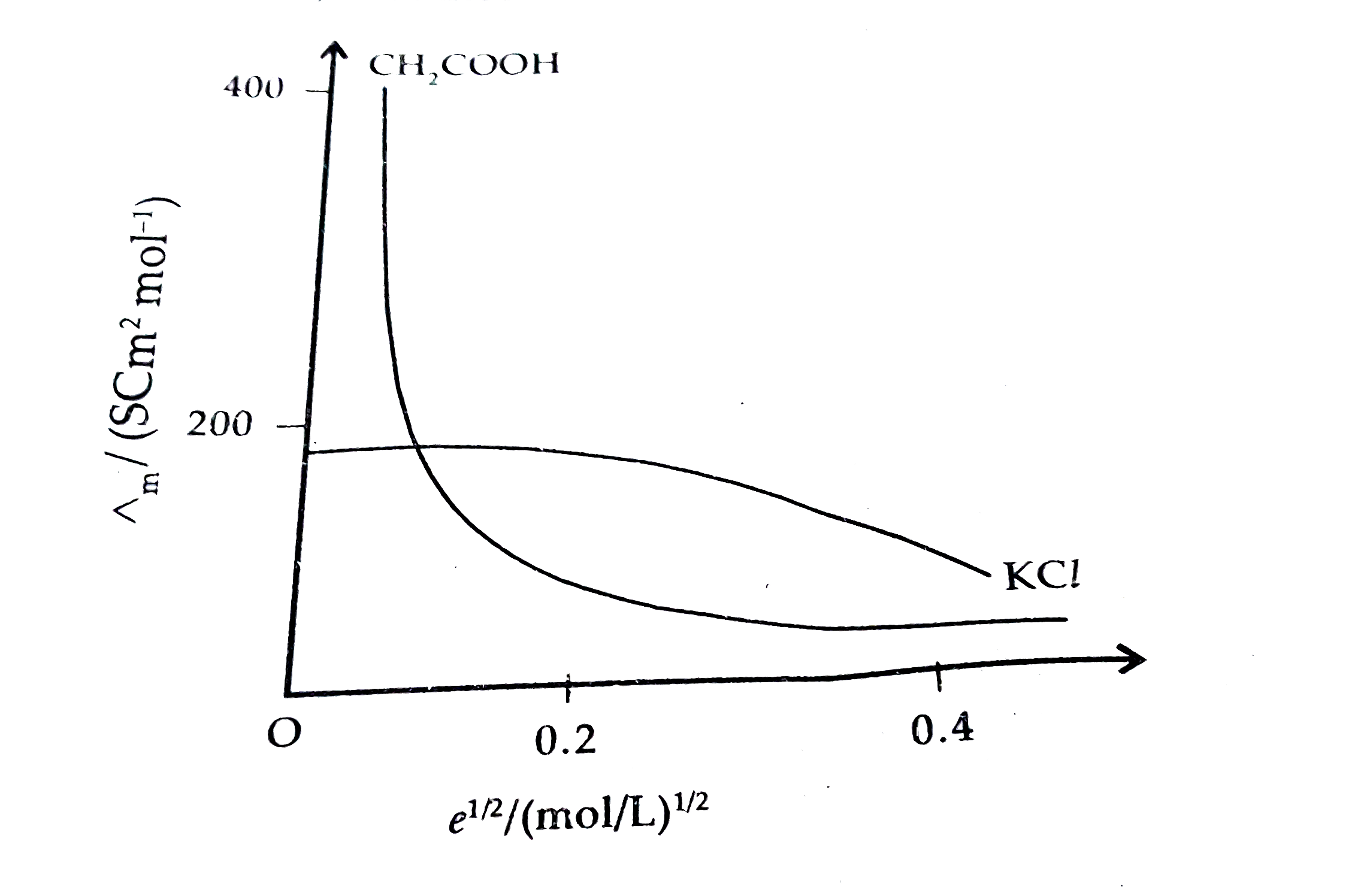Calculate ΔrG∘ and e.m.f. (E) that can be obtained from the following cell under the standard conditions at 25∘C:Zn(s)∣∣Zn2+(aq) Sn2+(aq)∣∣Sn(s)
Given E∘Zn2+/Zn=−0.76V,E∘Sn2+/Sn=−0.14V
And F=96500C mol−1
OR
(a) Define conductivity and molar conductivity for the solution of an electrolyte. Discuss their variation with concentration.
(b) Calculation the standard cell potential of the galvanic cell in which the following reaction takes place: Fe2+(aq)+Ag+(aq)→Fe3+(aq)+Ag(s)
Calculate the ΔrG∘ and equilibrium constant of the reaction also.
(E∘Ag+/Ag=0.80,E∘Fe3+/Fe2+=0.77V)
In the given equation n=2,
F=96500 C mol−1
E∘cell=−0.14V
Therefore, ΔrG∘=−2×−0.14V×96500× C mol−1=0.28×96500=27020Kj mol1
E∘cell=E∘ cathode−E∘anode
E∘cell=−0.14V−(−0.76)=0.14V+0.76=0.62V
ΔG∘=n F E∘cell
=−2×96500×0.62=−1.24×96500=−119600=−1.19660×105J/mol
OR
(a) Conductivity: Conductivity of a solution is equal to the conductance of a solution of 1 cm length and cross section area of 1 cm length and cross section area of 1 square cm. it may also be define as the conductance of in centimeter cube of the conductor. it is represented by the symbol kappa(K)
K=1/P
e is resistivity. the unit of K is ohm−1cm−1 or S cm−1. The conductivity,K, of a electrolytic solution depends on the concentration of the electrolyte. Natre of solvent and temperature.
Molar conductivity: Molar conductivity of a solution at given concentration is the conductance of the volume V of solution containing one mole of electrlyte Kept between two electrodes with area of cross section A and distance of Unit length. therefore, distance is Unit so
1=1
Volume=Area of bare×length
So, V=A×1
=A
∧m=KA/1
∧m=KV
(b) E∘cell=+0.80V−0.77V=+0.03V
ΔrG∘=nFE∘cell
=−1(mol)×(96500 C mol−1)×(0.03V)
=−2895 CV mol−1=−2895 S mol−1
ΔrG2=−2.303RT log KC
=−2895=−2.303×8.314×298×log KC
logKC=0.5074
KC=Antilog(0−5074)
KC=3.22

Topper's Solved these Questions
Similar Questions
Calculate the maximum possible electric work that can be obtained from the following cell under the standard conditions at 25∘C : Given
Zn∣∣Zn2+(aq)∣∣∣∣Sn2+(aq)∣∣Sn(s)
At 25∘C,E∘Zn2+(aq)∣Zn(s)=−0.76V
E∘Sn+(aq)∣Sn(s)=−0.14V.
F=96500C mol−1
View SolutionCalculate the maximum possible electrical work that can be obtined from the cell under the standard conditions at 298 K
Zn∣∣Zn2+(aq)∣∣∣∣Ni2+(aq)∣∣Ni(s)
Given E∘Zn2+(aq)∣∣Zn(s)=−0.76 V ,E∘Ni2+(aq)∣∣Ni(s)=−0.25 V
View Solution
Knowledge Check
What is the EMF of the cell?
Zn(s)∣∣Zn2++(0.1M)∣∣∣∣Sn2++(0.001M)∣∣∣Sn(s).
Given E∘Zn2+/Zn=0.76V,ESn∘2+/Sn=−0.14VA0.62VB0.56VC1.12VD0.31V
Calculate the maximum work that can be obtained from the daniell call given below,
Zn(s)∣∣Zn2+(aq)∣∣∣∣Cu2+(aq)∣∣Cu(s). Given that E∘Zn2+/Zn=−0.76V and E∘Cu2+/Cu=+0.34V.
View SolutionPredict whether the following redox reaction is feasible under the standard conditions or not.
Sn2+(aq)+Cu(s)→Sn(s)+Cu2+(aq)
Given : E∘Sn2+/Sn=−0.136 V and ECu2+/Cu=+0.34 V
View SolutionCalculate the emf of the following cell at 25∘C.
Zn∣Zn2+(0.001 M) || H+(0.01M)∣H2(1 bar) | Pt(s). Given that E∘(Zn2+/Zn)=−0.76V,E∘(H+/H2)=0.00 V
View SolutionCalculate the equilibrium constant K for the reaction at 298 K
Zn(s)+Cu2+(aq)<⇒Zn2+(aq)+Cu(s)
[Given: E∘Zn2+/Zn=−0.76V,E∘Cu2+/Cu=+0.34V ]
View SolutionCalculate the cell e.m.f. and ΔG for the cell reaction at 298 K for the cell.
Zn(s)∣∣Zn2+(0.0004M)∣∣∣∣Cd2+(0.2M)∣∣Cd(s)
Given E∘Zn2+/Zn=−0.763V,E∘cd2+/cd=−0.403V at 298K,F=96500C mol−1.
View SolutionCalculate the emf of the following cell at 25∘ C
Zn∣∣Zn2+(0.001M)∣∣∣∣H+(0.01M)∣∣H2(g)(1¯)∣Pt(s)
E∘Zn2+/Zn=−0.76V,E∘H+/H2=0.00V
View SolutionCalculate the cell e.m.f. and ΔG for the cell reaction at 298K for the cell.
Zn(s)∣∣Zn2+(0.0004M)∣∣∣∣Cd2+(0.2M)∣∣Cd(s)
Given, E∘Zn2+/Zn=−0.763V,E∘Cd+2/Cd=−0.403V at 298K.
F=96500Cmol−1.
View Solution

